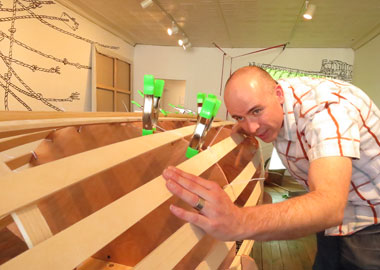Outside the Oxbow Gallery rests an odd contraption. A steam kettle sits on a hot plate. From its spout, a piece of garden hose exits. The hose then enters a long rectangular box made of cut-up insulation of some sort. Here and there, a bit of steam leaks out.
It’s clear that this isn’t a landscape show. It’s not at all clear what’s happening inside the box until artist Samuel Rowlett comes over to explain. He’s steaming wood to bend for the canoe he’s making inside. If that were all he was doing, you might think the Oxbow had been taken over by a half-baked (or half-steamed) performance artist.
Enter the Gallery, however, and it seems the place has been transformed into something between a workshop and an exhibition. The effect is strange: a blank canvas with notches in the top holds books. This is clearly “a piece.” So is the giant canvas with a backpack attached for carrying. But tools? Probably not “a piece.” A video of Rowlett carting the backpack-canvas through the wilderness plays in the corner.
“Sometimes the wind would catch it,” says Rowlett, “and I’d go down face first.”
When he speaks—and Rowlett is quite animated and articulate—you might eventually catch a hint of pronunciation from other shores. It’s only a hint, though—he was born in England, but seems to have absorbed plenty of American speech patterns.
Rowlett didn’t start out with heady concepts like carting canvases through the woods; his training was in representational art, and he describes a long-term grind of rendering figures. His work, he explains, largely took place within the usual bounds of a canvas. Then he became a father, and his newfound time constraints demanded a new economy in his work. That led him to wall drawings.
“No more huge canvas,” he says. “You just show up with your stuff and draw on the wall.”
From there, he branched out to a peculiar brand of art, one which involves and includes a much larger environment than just a studio or gallery; his current project culminates in large-scale wandering with his canoe.
It might be tempting to ask if all this is art, but the best policy by far is to forget that question. Why worry over corraling things into artificial definitions when you could instead be enjoying the incarnations of a particularly interesting imagination?
Rowlett is exploring in many ways. The Oxbow Gallery holds toolboxes, plans, drawings, paintings, video, and even a stack of wood beneath the half-finished canoe. It’s become something more like a studio, as if he threw open the doors well in advance of a traditional show. “I’m interested in extending my work out of the studio,” says Rowlett. “I want to link the exploration of studio process and our local environment.”
That’s why he’s taking the new canoe down the Connecticut. He’s porting at the Holyoke dam, even camping in an alley, en route to another of his exhibitions at Real Art Ways in Hartford.
You’ve got to admire an artist who will, in pursuit of his art, set forth in the first canoe he’s ever built.
Rowlett draws a piece out of the steamer to show me how flexible it’s become. He bows it over, hard. It looks impressive. Then it snaps with a loud crack.
“Trial and error,” he says, unruffled, even smiling.
Abandoned Meanders exhibition: through May 27; gallery talk with Kim Lutz of the Nature Conservancy: May 29, 7 p.m., Oxbow Gallery, 275 Pleasant St., Northampton.



